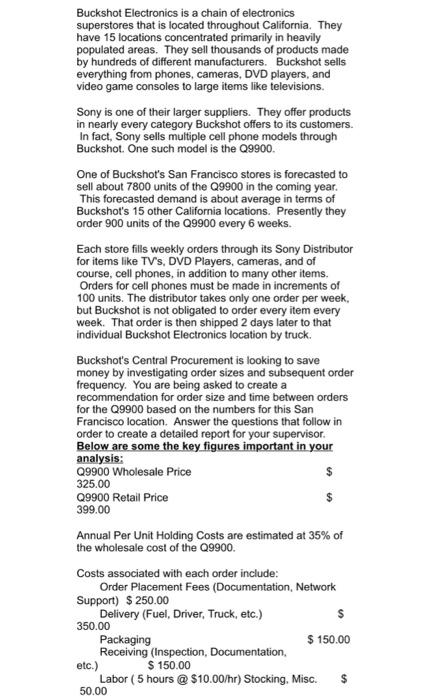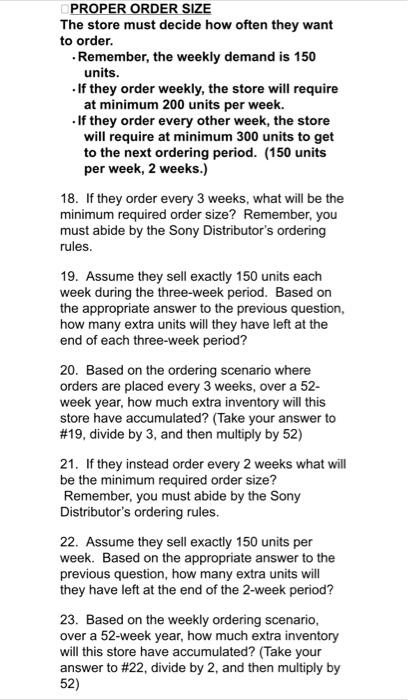this class is stumping me, I need help with this, if anyone could!! It would be appreciated!!
Buckshot Electronics is a chain of electronics superstores that is located throughout California. They have 15 locations concentrated primarily in heavily populated areas. They sell thousands of products made by hundreds of different manufacturers. Buckshot sells everything from phones, cameras, DVD players, and video game consoles to large items like televisions. Sony is one of their larger suppliers. They offer products in nearly every category Buckshot offers to its customers. In fact, Sony sells multiple cell phone models through Buckshot. One such model is the Q9900. One of Buckshot's San Francisco stores is forecasted to sell about 7800 units of the Q9900 in the coming year. This forecasted demand is about average in terms of Buckshot's 15 other California locations. Presently they order 900 units of the Q9900 every 6 weeks. Each store fills weekly orders through its Sony Distributor for items like TV's, DVD Players, cameras, and of course, cell phones, in addition to many other items. Orders for cell phones must be made in increments of 100 units. The distributor takes only one order per week, but Buckshot is not obligated to order every item every week. That order is then shipped 2 days later to that individual Buckshot Electronics location by truck. Buckshot's Central Procurement is looking to save money by investigating order sizes and subsequent order frequency. You are being asked to create a recommendation for order size and time between orders for the Q9900 based on the numbers for this San Francisco location. Answer the questions that follow in order to create a detailed report for your supervisor. Below are some the kev fiaures imnortant in vour Annual Per Unit Holding Costs are estimated at 35% of the wholesale cost of the Q9900. Costs associated with each order include: Order Placement Fees (Documentation, Network Support) $250.00 Delivery (Fuel, Driver, Truck, etc.) 350.00 Packaging $150.00 Receiving (Inspection, Documentation, etc.) \$150.00 Labor ( 5 hours @ \$10.00/hr) Stocking, Misc. \$ 50.00 24. Realistically, which of the following options is most attractive? An attractive option is one where the order size is close or equal to the EOQ, abides by the distributor's ordering rules, and minimizes the amount of unnecessary inventory. (We will call this Q ) According to the appropriate recommendation you provided in \#24, what would be the Total Annual Inventory cost? Also, separately identify, the annual holding cost (AHC) and annual ordering cost (AOC). 25. Using the Q, what is the annual holding cost (AHC)? (Choose the closest answer) 26. Using the Q, what is the annual ordering cost (AOC)? (Choose the closest answer) 27. What is the total annual cost of inventory, TC? (Q=Q) (Choose the closest answer) 28. The total annual savings for this one store using our recommendation (Q) versus the present lot size of 900 , would be: TOTAL SAVINGS ALL STORES 29. Without store-by-store information it is difficult to say how much this would save the corporation. Nonetheless, using only the numbers for this store it can be said that if the numbers for the other 14 stores are similar there is a potential to save a total of about... Remember, there are 15 stores, total! 9. What is the annual holding cost, AHC ? (Q= 900) (Choose the closest answer) 10. What is the total annual cost of inventory, TC? (Q=900) (Choose the closest answer) Using the Economic Order Quantity (Q=EOQ) 11. What is the EOQ? (Choose the closest answer) 12. Using the calculated EOQ, how often will orders be placed? All answers are in weeks. (Choose the closest answer) According to the information supplied, what would be the annual inventory cost if they used the calculated EOQ? Also, separately identify the annual holding cost (AHC) and annual ordering cost (AOC). 13. Using the calculated EOQ, what is the annual holding cost (AHC)? (Choose the closest answer) 14. Using the calculated EOQ, what is the annual ordering cost (AOC) ? (Choose the closest answer) 15. What is the total annual cost of inventory, TC? (Q=EOQ) (Choose the closest answer) 16. If they could order the EOQ instead of 900 , how much would this one store stand to save annually? 17. Why is this not possible for this company to use the calculated EOQ as their order size? THE GIVENS 1. What is the annual demand for one store? Find D: (Choose the closest answer) 2. What is the per unit annual holding for one store? Find h: (Choose the closest answer) 3. What is the per unit cost for each item? Cost is the amount the company pays their supplier per unit. Find C: (Choose the closest answer) 4. What is the cost to place one order? In other words, every time the company places an order, which costs are incurred? Find S: (Choose the closest answer) 5. What is the weekly demand? Find D/52: (Choose the closest answer) Using Present Lot Size (Q=900) 6. How many orders per year are being placed annually? (Q=900) Do Not Round. (Choose the closest answer) According to the information supplied, what is the present annual inventory cost? (In other words, using their present lot size what is the annual inventory cost?) Also, separately identify, the annual cost of purchasing the inventory, the annual holding cost ( AHC ) and annual ordering cost (AOC). 7. What is the annual cost to purchase the items? (Q=900) (Choose the closest answer) 8. What is the annual ordering cost, AOC ? (Q= 900) (Choose the closest answer)











